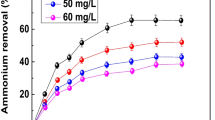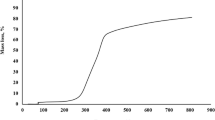Abstract
The adsorption of benzene vapor, as a volatile organic component, from inert gas (N2) by activated carbon was studied experimentally in the isothermal fixed bed reactor at various operating conditions. The activated carbon used in this study had pistachio shell base with high surface area. To improve the adsorption capacity of VOC vapor, the activated carbon was chemically treated with H2SO4, HNO3, NaOH, and NH3 solutions. The saturated adsorption capacities of benzene on initial activated carbon and treated samples were measured and compared. The results showed that the activated carbon treated with nitric acid had higher adsorption capacity than others samples, 640 mg/g. In addition, a mathematical model for adsorption in a fixed bed reactor was proposed in this study. The model results had good agreement with experimental data. In order to demonstrate the effects of operating conditions on adsorption and breakthrough curve, the experimental tests and simulation runs were carried out at various gas flow rate, temperature, and benzene concentration. The results showed that with increase VOC concentration from 700 to 1000 ppm, the total time of adsorption was decreased from 25 to 21 h and breakthrough point appeared earlier.









Similar content being viewed by others
Data availability
All data generated or analyzed during this study are included in this published article
Abbreviations
- a :
-
external surface area per unit volume of the activated carbon, m2/m3
- a*:
-
total adsorption surface area per unit volume of the activated carbon, m2/m3
- C :
-
concentration, mol/m3
- C G :
-
concentration of the species in the gas bulk, mol/m3
- C p :
-
molar concentration of species inside the pores, mol/m3
- C s :
-
molar surface concentration of adsorbed species inside the pores, mol/m2
- De:
-
effective diffusivity inside pore, m2/s
- d p :
-
diameter of the fiber, m
- D k :
-
Knudsen diffusivity, m2/s
- D m :
-
molecular diffusivity, m2/s
- k m :
-
average mass film transfer coefficient around the adsorbent particle, m/s
- k a :
-
rate constant for adsorption, m/s
- k d :
-
rate constant for desorption, mol/s-m2
- M :
-
molecular weight of gas, g/mol
- Q :
-
volumetric flow rate of the gas, mL/min
- R p :
-
pore radius, m
- R e :
-
Reynolds number
- Sc:
-
Schmidt number
- Sh:
-
Sherwood number
- T :
-
temperature, K
- ε :
-
porosity of bed
- α :
-
porosity of carbon particle
References
Anfruns A, Martin Mar J, Montes-Moran MA (2011) Removal of odorous VOCs using sludge-based adsorbents. Chem Eng J 166:1022–1031. https://doi.org/10.1016/j.cej.2010.11.095
Berenjian A, Chan N, Jafarizadeh Malmiri H (2012) Volatile organic compounds removal methods: a review. Am J Biochem Biotechnol 8:220–229. https://doi.org/10.3844/ajbbsp.2012.220.229
Chao CYH, Kwong CW, Hui KS (2007) Potential use of a combined ozone and zeolite system for gaseous toluene elimination. J Hazard Mater 143:118–127. https://doi.org/10.1016/j.jhazmat.2006.08.077
Debasish D, Vivekanand G, Nishith V (2004) Removal of volatile organic compound by activated carbon fiber. Carbon 42:2949–2962. https://doi.org/10.1016/j.carbon.2004.07.008
Faisal IK, Ghoshal AK (2000) Removal of volatile organic compounds from polluted air. J Loss Prev Process Ind 13:527–545. https://doi.org/10.1016/S0950-4230(00)00007-3
Geankoplis CJ (1983) Transport processes momentum heat and mass. Allyn &Bac.
Gil RR, Ruiz B, Lozano MS, Martín MJ, Fuente E (2014) VOCs removal by adsorption onto activated carbons from biocollagenic wastes of vegetable tanning. Chem Eng J 245:80–88. https://doi.org/10.1016/j.cej.2014.02.012
Gupta VK, Verma N (2002) Removal of volatile organic compounds by cryogenic condensation followed by adsorption. Chem Eng Sci 57:2679–2696. https://doi.org/10.1016/S0009-2509(02)00158-6
Kim KJ, Kang CS, You YJ, Chung MC, Wu WM, Woon-Jo et al (2006) Adsorption–desorption characteristics of VOCs over impregnated activated carbons. Catal Today 111:223–228. https://doi.org/10.1016/j.cattod.2005.10.030
Li W, Gong H (2010) Recent progress in the removal of volatile organic compounds by catalytic combustion. Acta Phys -Chim Sin 26:885–894. https://doi.org/10.3866/PKU.WHXB20100436
Li L, Liu S, Liu J (2011) Surface modification of coconut shell based activated carbon for the improvement of hydrophobic VOC removal. J Hazard Mater 192:683–690. https://doi.org/10.1016/j.jhazmat.2011.05.069
Mirzaei A, Leonardi SG, Neri G (2016) Detection of hazardous volatile organic compounds (VOCs) by metal oxide nanostructures-based gas sensors: a review. Ceram Int 42. https://doi.org/10.1016/j.ceramint.2016.06.145
Nikolajsen K, Kiwi-Minsker L, Renken A (2006) Structured fixed-bed adsorber based on zeolite/sintered metal fibre for low concentration VOC removal. Chem Eng Res Des 84:562–568. https://doi.org/10.1205/cherd.05220
Ozturk B, Yilmaz D (2006) Absorptive removal of volatile organic compounds from flue gas streams. Process Saf Environ Prot 84:391–398. https://doi.org/10.1205/psep05003
Rene ER, Sergienko N, Goswami T, Estefanía López M, Kumar G, Saratale GD, Venkatachalam P, Pakshirajan K, Swaminathan T (2017) Effects of concentration and gas flow rate on the removal of gas-phase toluene and xylene mixture in a compost biofilter. Bioresour Technol 248:28–35. https://doi.org/10.1016/j.biortech.2017.08.029
Sidheswaran MA, Destaillats H, Sullivan DP, Cohn S, Fisk WJ (2012) Energy efficient indoor VOC air cleaning with activated carbon fiber (ACF) filters. Build Environ 47:357–367. https://doi.org/10.1016/j.buildenv.2011.07.002
Smith JM (1996) Chemical engineering kinetics. New York, NY: Mc Graw-Hill.
Sona HK, Sivakumarb S, Roodc MJ, Kim BJ (2016) Electrothermal adsorption and desorption of volatile organic compounds on activated carbon fiber cloth. J Hazard Mater 301:27–34. https://doi.org/10.1016/j.jhazmat.2015.08.040
Swetha G, Gopi T, Chandra Shekar S, Ramakrishna C, Bijendra S, Rao PVL (2016) Combination of adsorption followed by ozone oxidation with pressure swing adsorption technology for the removal of VOCs from contaminated air streams. Chem Eng Res Des 117:725–732. https://doi.org/10.1016/j.cherd.2016.11.036
Talu O (2013) Net adsorption of gas/vapor mixtures in microporous solids. J Phys Chem C 117:13059–13071. https://doi.org/10.1021/jp4021382
Valenciano R, Aylon E, Izquierdo MT (2015) A critical short review of equilibrium and kinetic adsorption models for VOCs breakthrough curves modelling. Adsorpt Sci Technol 33:851–869. https://doi.org/10.1260/0263-6174.33.10.851
Veerapandian SKP, Leys C, Geyter ND, Morent R (2017) Abatement of VOCs using packed bed non-thermal plasma reactors: a review. Catalysts 7:113–133. https://doi.org/10.3390/catal7040113
Walton KS, Sholl DS (2015) Predicting multicomponent adsorption: 50 years of the ideal adsorbed solution theory. AICHE J 61:2757–2762. https://doi.org/10.1002/aic.14878
Xian S, Yu Y, Xiao J, Zhang Z, Xia Q, Wang H, Li Z (2015) Competitive adsorption of water vapor with VOCs dichloroethane, ethyl acetate and benzene on MIL-101(Cr) in humid atmosphere. RSC Adv 5:1827–1834. https://doi.org/10.1039/C4RA10463C
Yang RT (1998) Gas separation by adsorption processes. Imperial College Press, London
Author information
Authors and Affiliations
Contributions
All authors contributed to the study conception and design. Material preparation, data collection, and analysis were performed by Maryam Mirzaie, Ali Reza talebizadeh, and Hasan Hashemipour. The first draft of the manuscript was written by Maryam Mirzaie, and all authors commented on previous versions of the manuscript. All authors read and approved the final manuscript.
Corresponding author
Ethics declarations
Competing interests
The authors declare that they have no competing interests.
Additional information
Responsible Editor: Tito Roberto Cadaval Jr.
Publisher’s note
Springer Nature remains neutral with regard to jurisdictional claims in published maps and institutional affiliations.
Rights and permissions
About this article
Cite this article
Mirzaie, M., Talebizadeh, A.R. & Hashemipour, H. Mathematical modeling and experimental study of VOC adsorption by Pistachio shell–based activated carbon. Environ Sci Pollut Res 28, 3737–3747 (2021). https://doi.org/10.1007/s11356-020-10634-1
Received:
Accepted:
Published:
Issue Date:
DOI: https://doi.org/10.1007/s11356-020-10634-1




